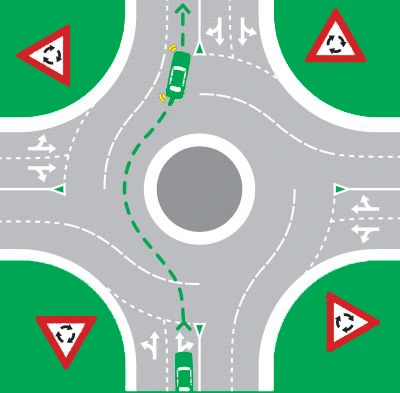Safe Lane Changes: Key Tips for Ontario Drivers
Safe lane changes are a crucial aspect of responsible driving, contributing to overall road safety and preventing accidents. For Ontario drivers, understanding and implementing key tips for safe lane changes is essential for a smooth and secure driving experience. This guide aims to provide detailed insights into the best practices for lane changes on Ontario roads.
Safe lane changes are a critical skill for drivers aiming to pass their driving test in Ontario, Canada. These maneuvers not only ensure the safety of all road users but also demonstrate a driver’s competence and responsibility. Key fundamentals include using turn signals effectively and mastering the art of merging onto highways. When changing lanes, the timely activation of turn signals is paramount, giving other drivers sufficient notice of your intentions. Practicing this precision, ideally signaling at least 100 feet before the intended lane change, contributes to smoother traffic flow. here we present some key tips for Ontario Drivers related to safe lane changes
Turn Signals Importance in safe lane changes
The utilization of turn signals while driving holds immense significance in bolstering road safety and fostering effective communication on the streets. Beyond being a legal requirement, the act of signaling one’s intentions through these simple yet vital indicators plays a pivotal role in averting potential accidents and reducing the risk of collisions.
Turn signals function in lane changes work as a universal language among motorists, enhancing predictability and allowing fellow drivers to adjust their speed and position accordingly. By employing turn signals, drivers contribute to the prevention of misunderstandings on the road, thereby minimizing the likelihood of abrupt maneuvers that could lead to accidents.
Turn signal proper use during lane change
The proper use of turn signals during lane changes is a fundamental practice that significantly enhances road safety. When changing lanes, it is essential to activate the turn signal well in advance of the intended maneuver. This early signaling provides ample notice to other drivers, allowing them to anticipate and adjust their speed or position accordingly.
The purpose of the turn signal is to communicate one’s intentions clearly, fostering a predictable and organized flow of traffic. Additionally, drivers should ensure that the signal remains activated throughout the entire lane change, maintaining a constant alert to those in their vicinity. The proper use of turn signals during lane changes not only complies with traffic regulations but also plays a crucial role in preventing misunderstandings, reducing the risk of collisions, and contributing to an overall safer and more efficient driving experience.
How fast you have to signal before lane change?
Signaling well in advance of changing lanes or merging onto a different roadway is paramount for safe and efficient driving. Ideally, drivers should activate their turn signals at least 100 feet before the intended maneuver. This early signaling provides fellow motorists with adequate time to recognize the impending lane change, allowing them to adjust their speed or position accordingly.
The importance of this lane changes lead time cannot be overstated, as it enhances overall communication on the road, reduces the risk of misunderstandings, and promotes a smoother traffic flow. By adhering to the principle of signaling early, drivers contribute to a safer driving environment, ensuring that everyone on the road can navigate transitions with predictability and caution.
Tips for Safe and Stress-free Driving when merging onto Highway
Merging onto highways is a crucial aspect of driving that requires a combination of awareness, timing, and adherence to safety measures. These tips aim to facilitate a safe and stress-free experience when merging onto highways.
- Use acceleration lanes effectively:
- Take advantage of acceleration lanes to match the speed of highway traffic. Use this space to reach a comparable speed, allowing for a seamless transition into the flow of vehicles.
- Check traffic flow:
- Before merging, assess the flow of traffic on the highway. Identify gaps between vehicles and choose an opportune moment to merge, avoiding situations where merging may disrupt the existing traffic pattern.
- Activate Your Turn Signal:
- Signal your intention to merge by activating your turn signal well in advance. Signaling communicates your plans to other drivers, giving them the opportunity to adjust their speed and make way for a smoother merge.
- Check Blind Spots:
- Perform thorough checks of your blind spots by looking over your shoulder before merging. This precaution ensures that you are aware of any vehicles that are not visible in your mirrors.
- Adjust Your Speed:
- Adjust your speed to match the highway traffic. Sudden accelerations or decelerations can lead to safety hazards. Aim for a seamless merge by blending with the speed of the vehicles on the highway.
- Be mindful of large vehicles.
- Take extra caution when merging in the vicinity of larger vehicles, such as trucks or buses. These vehicles may have limited visibility, so ensure that you are visible to them and leave ample space for their maneuvers.
- Anticipate Oncoming Traffic:
- Keep an eye on the oncoming traffic from the highway ramps. Anticipate the movement of vehicles entering the highway from other ramps to avoid potential conflicts.
- Merge Promptly but Safely:
- Once an appropriate gap is identified, merge promptly but safely. Avoid lingering in acceleration lanes or making sudden movements that may surprise other drivers.
- Maintain a Safe Following Distance:
- After merging onto the highway, maintain a safe following distance from the vehicle ahead. This provides a buffer in case of sudden stops and allows for smoother traffic flow.
- Stay calm and confident:
- Confidence is key when merging onto highways. Stay calm, maintain focus, and execute your merge with assurance. Avoid hesitations that can create uncertainty among other drivers.
Smoothly and Confidently Lane Changes
Lane changes smoothly and confidently is an essential skill for drivers, ensuring a safe and efficient flow of traffic. Here are some key strategies to master this aspect of driving:
- Signal Early and Clearly:
- The foundation of a smooth lane change begins with signaling. Activate your turn signal well in advance of your intended move to communicate your intentions clearly to other drivers. This early signal provides ample time for those around you to react and adjust accordingly.
- Check Mirrors and Blind Spots:
- Before changing lanes, conduct a comprehensive check of your mirrors, including the rearview and side mirrors. However, mirrors have limitations, and a crucial step is to perform a shoulder check to eliminate blind spots. Ensure that no vehicles are lurking in areas not covered by your mirrors.
- Maintain a Consistent Speed:
- Changing lanes smoothly involves maintaining a consistent speed with the flow of traffic. Abrupt changes in speed can lead to disruptions and potentially dangerous situations. Aim for a fluid transition to blend seamlessly into the new lane.
- Anticipate Traffic Flow:
- Develop a sense of anticipation regarding the traffic around you. Pay attention to the behavior of other drivers, road signs, and potential obstacles. This awareness allows you to time your lane changes effectively and make informed decisions.
- Choose the Right Gap:
- Select an appropriate gap in the adjacent lane before initiating your lane change. Attempting to change lanes in heavy traffic or in spaces that are too small can lead to congestion and frustration for both you and other drivers.
- Execute Smooth Steering Movements:
- When changing lanes, use gentle and smooth steering movements. Avoid sudden jerks or aggressive maneuvers, as they can startle other drivers and compromise safety.
- Be Cognizant of Surrounding Vehicles:
- Stay aware of the vehicles around you, especially those in your immediate vicinity. Adjust your speed and lane change timing to accommodate the flow of traffic, creating a seamless transition without disrupting others.
- Use Freeway Ramps Strategically:
- When on freeways, utilize acceleration and deceleration lanes effectively. Signal and merge smoothly when entering a freeway, and plan your lane change well in advance when exiting to ensure a safe and confident transition.
- Stay Focused and Minimize Distractions:
- Distractions can compromise your ability to change lanes smoothly. Stay focused on the road, minimize distractions like phone use or adjusting settings, and keep your attention on the task at hand.
- Practice Defensive Driving:
- Embrace a defensive driving mindset. Anticipate the actions of other drivers and be prepared for unexpected maneuvers. Maintaining a cautious approach contributes to a safer driving experience.
In conclusion, changing lanes smoothly and confidently is a blend of effective communication, awareness, and considerate driving. By incorporating these strategies into your driving habits, you can navigate the roads with confidence, contribute to a harmonious traffic environment, and ensure the safety of yourself and others on the road.
Allocation of Safe Space between Vehicles
Locating safe spaces between vehicles is a critical skill that underscores responsible and defensive driving. This ability not only enhances personal safety but also contributes to the overall fluidity of traffic. The process involves a combination of spatial awareness, anticipation, and a commitment to maintaining appropriate distances between your vehicle and others on the road.
First and foremost, maintaining a safe following distance is paramount. Adhering to the “Three-Second Rule” serves as a practical guideline, allowing drivers to calculate a suitable distance based on their speed. This rule provides a buffer that accommodates unforeseen circumstances, reducing the risk of rear-end collisions.
Anticipating the actions of other drivers is another key element in locating safe spaces between vehicles. By monitoring brake lights, turn signals, and the general behavior of surrounding vehicles, drivers can make informed decisions and position themselves strategically on the road. This foresight is particularly crucial in heavy traffic, where identifying safe spaces becomes more challenging but equally essential.
Regular checks of rearview and side mirrors contribute to a comprehensive understanding of the traffic environment. Being aware of the positions and movements of vehicles in neighboring lanes facilitates safer lane changes and adjustments. Moreover, eliminating blind spots through shoulder checks enhances the driver’s ability to locate safe spaces during maneuvers.
Tailgating, or following too closely, poses a significant hazard on the road. Maintaining a respectful distance from the vehicle in front allows for a better line of sight and reaction time. Adjusting speed to match the flow of traffic is equally important, preventing disruptions in the established safe spaces and minimizing the risk of abrupt stops.
Common error related to Lane Changes and Merger
Common lane changes and merge errors can pose significant risks on the road, leading to accidents and traffic disruptions. Recognizing and avoiding these mistakes is crucial for safe and efficient driving. One common error is inadequate signaling, where drivers fail to indicate their intention to change lanes or merge, leading to confusion and potential collisions. Another frequent mistake is improper checking of blind spots, overlooking vehicles that may be hidden from view in mirrors. Tailgating, or following too closely, during lane changes and merges is another prevalent error that compromises safety.
Conclusion
Implementing these key tips for safe lane changes is vital for promoting road safety in Ontario. By adopting responsible driving habits, Ontario drivers contribute to a safer and more efficient traffic environment for everyone. Remember, a small act of caution can go a long way in preventing accidents and ensuring a smooth commute for all road users. You had to follow these tips if you want safe lane changes as a driver in Ontario.







